Tour surfing: "The first time offshore - it was intimidating!" Interview with Marinus Tambo & Alfred Dixen
Manuel Vogel
· 26.10.2024






You returned from your tour of Denmark a few days ago. How much of the exertion is still in your bones?
Marinus: The last two days were particularly exhausting due to the strong wind, we were completely overpowered. But after two days we were fine again. We also made sure to get enough rest during the trip. The days are quite short in Denmark in October and the nights are correspondingly long. We had nine or ten hours of sleep every night (laughs).
Let's take a look back at the beginnings. Who had the idea?
Alfred: (Laughs) The idea came to us a year ago after Caspar Steinfath, a well-known Danish SUP paddler, took a trip around Denmark in 2022. Around Denmark on a windsurfer - no one had ever done that before. Marinus and I decided to go for it in autumn 2024, after the iQFoil World Championships.

It was obvious that you would do this on foil boards, wasn't it? Or was a fin board an option?
Marinus: No, as iQFoil surfers we are naturally at home on the foilboard and knew that we could ride much better angles to the wind than on the fin. What's more, unlike Caspar Steinfath, we wanted to sail around the whole of Denmark. That included Bornholm and, as we know, this island is quite far from the mainland. It started as a fixed idea in our heads and then became more and more concrete. I think because we made so many jokes about it, many people in our circle of friends didn't believe that we would go through with it. And our parents thought that we would come crawling back home after a few days because the offshore routes were too hard or our sleeping bags were soaked in the Danish autumn (laughs).
Why did you even plan this for autumn? October can be quite unpleasant here in the north?
Alfred: There were other appointments before and after that got in the way. What's more, it's always windy at this time of year. That proved to be the case - out of 13 days travelling, we only had two days without wind on which we made no progress. And the temperatures are still ok, the water is still 14 degrees.
What speaks against the foilboard is the luggage. On a longboard with a fin, you can simply strap it on, but on a foilboard it completely throws off your balance...
Marinus: (Laughs) We did a dress rehearsal to Samso Island. The backpack option was too uncomfortable, so we strapped the luggage to the tail. That was also super frustrating because half the time it was hanging in the back of the water and felt like a tonne of seaweed on the foil (laughs). We knew we needed a better solution - the problem was that it was shortly before our planned departure. A boat builder friend offered to help us and built us a kind of luggage rack for the tail out of carbon fibre. We then spent the last few days tinkering with it non-stop.
A boat builder friend of ours offered to help us and built us a kind of luggage rack for the tail out of carbon fibre.
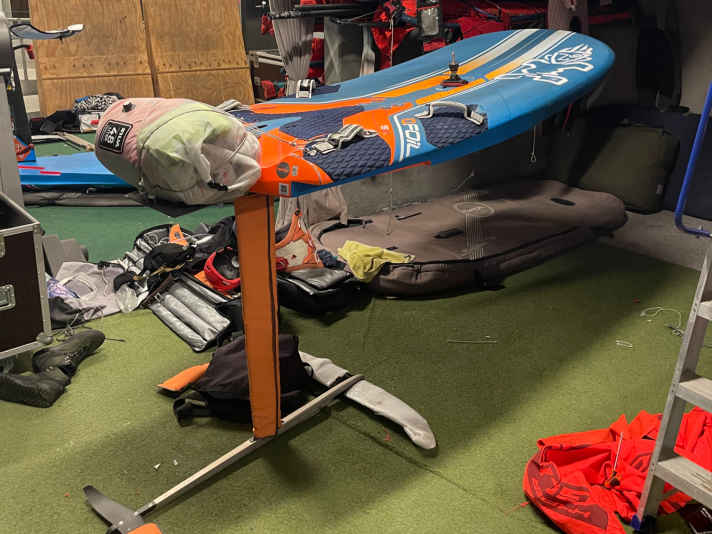
Did you even have time to try out the construction?
AlfredThat was a funny story (laughs). Danish television had contacted us, they wanted to film a TV programme two days before departure, for which we were to film with all our luggage. The problem was that we hadn't tried out our construction yet. It turned out that the handling of the board was quite affected by the extra luggage and the board was much slower to steer.
Marinus: We took quite a lurch and just tried to go halfway straight and not make any jibes (laughs). If you don't know anything about windsurfing, you probably didn't notice this in the film, but our friends had a good laugh.
How much luggage did you have with you?
Marinus: Everyone had around 8.5 kilos of luggage, so only the bare essentials. Tent, cooker, sleeping bag, inflatable mattress and one set of clothes, plus woollen underwear and jacket.
Alfred: We also had a power bank, dry food and a small camera.
Everyone had around 8.5 kilos of luggage with them, so only the bare essentials.
How often did you actually spend the night on the beach?
Marinus: The plan was to have everything we needed to survive for two days and to stock up on food somewhere else. On most days we actually just landed somewhere, looked for the best place for our tent, set everything up and went to bed early.
Alfred: We were surprised how many people contacted us and offered to spend the night in their summer house, but we actually only did that twice. Our idea was to surf as long as possible every day and start early again in the morning. The alarm clock rang at 6 a.m. because it took us an average of two hours to dismantle everything and stow it back on the boards.
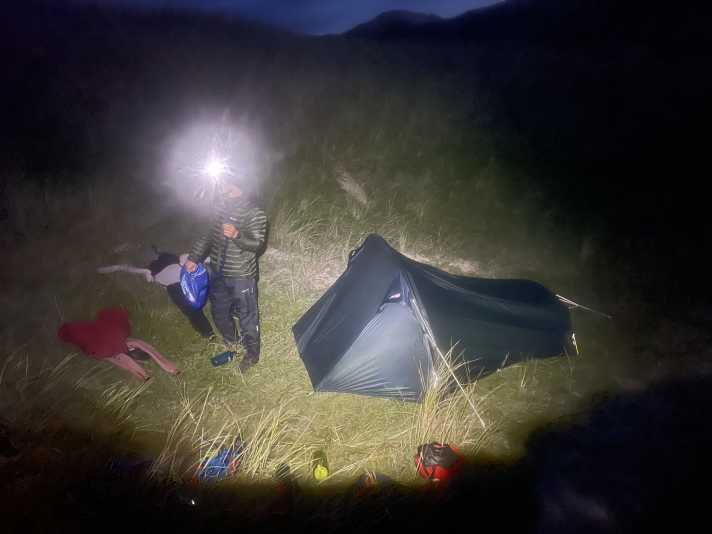
You covered 1400 kilometres in less than two weeks. How many hours a day were you on the water?
Marinus: As the crow flies, our route was 1400 kilometres long, but we actually surfed 1648 kilometres. There was a lull on two days when we had to take a break, so we completed the route in eleven days, usually spending seven to eight hours on the water. Our daily record was 224 kilometres. But that's only possible if you don't push too hard and aren't travelling at absolute top speed. Surprisingly, our cruising speed wasn't that far off the speeds we reach in the race. The rule was that we went ashore an hour before dark to have a bit of a buffer in case something went wrong.
That brings us to the topic of safety. How were you organised here?
Alfred: We had Garmin GPS trackers with an SOS button, but that would have been the last exit. We also had signal flares and walkie-talkies so that we could communicate with each other. We made sure that we were always within sight of each other, as the range of the walkie-talkies was limited. We realised this on the very first day: if each of us took off on the opposite course and foiled for two minutes, we could no longer reach each other via walkie talkie.
Foil equipment is sensitive and you can't surf almost 1700 kilometres without crashing. How did your equipment hold up?
Marinus: Of course, crashes happened from time to time. I broke a batten on the very second day. I repaired it by pushing a toothbrush into the tube batten and fixing it with tape. It held until the end.
I broke a batten on the very second day. I then repaired it by pushing a toothbrush into the tube batten and fixing it with tape.
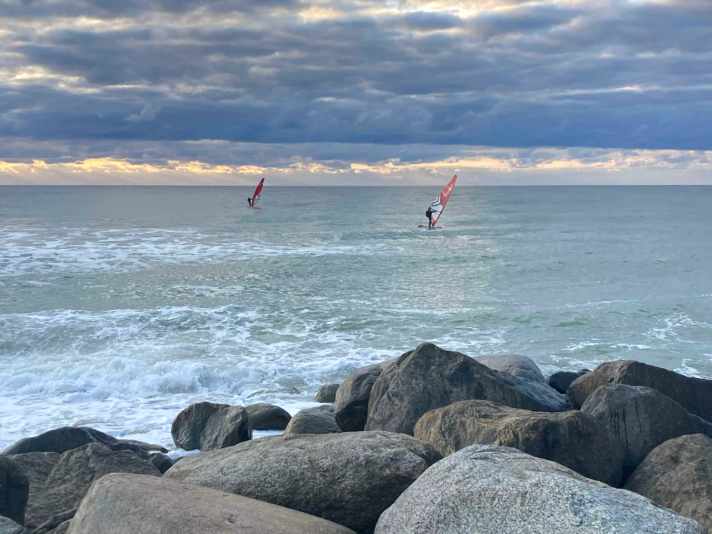
But Alfred had to put up with your bad breath until the end...
Marinus: (Laughs) No, luckily it wasn't my own toothbrush.
Looking back, what were the biggest challenges on the trip?
Marinus: One challenge was certainly the circumnavigation of Bornholm, or rather the way back. Our first start attempt ended in the doldrums and we had to paddle back along the steep and very rocky north coast, dragging all our equipment around.
Alfred: Setting off and ending up back where you started hours before was the lowest point of the trip for me mentally (laughs).
Marinus: When we set off a day later in stronger winds from a north-westerly direction, we originally wanted to head for the Swedish mainland. At some point, we found ourselves in the middle of the Baltic Sea in the middle of nowhere and looked at the map and realised that it would be better to foil directly to Mön instead of taking the supposedly shorter route to southern Sweden. In the end, this meant foiling 150 kilometres in the same direction, only then did the first tack come.
Setting off and ending up back where you started hours before was the lowest point of the trip for me mentally (laughs).
The feeling of being surrounded only by water is rather rare on the Baltic Sea. Does it ever make your heart sink?
Marinus: The first time we were "offshore" was when we surfed from Skagen to Laeso, which was about 50 kilometres across the open Kattegat. There was about an hour on the way when we couldn't see any land, which was intimidating but good training for the big crossing from Bornholm to Mon, where land was out of sight for about five hours.
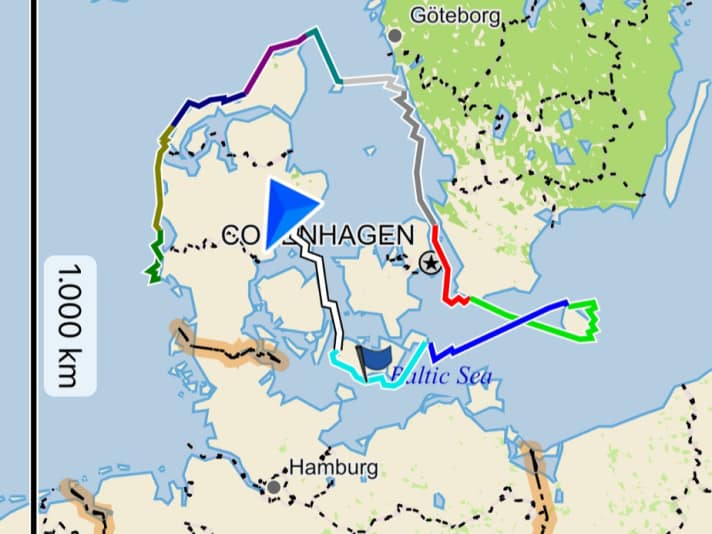
150 kilometres in the same posture - how do you keep it up?
Alfred: You get used to it (laughs). Of course, at some point your bones hurt and then you try to use the trim system to shift the sail pull from one hand to the other or simply find a slightly different position on the board. On the last stage, I was really stressed with my operated shoulder, so it was a bit too much.
Marinus: We also changed our entire setup in some cases. If we knew that today was going to be a day with a tailwind and a lot of room winds, we mounted the foot straps forwards in the morning because it's much easier to keep the board down. We only learnt a lot of these things along the way. On the first day, we only did 50 kilometres in the first four hours because one board had problems getting onto the foil in light winds. Every time we took off, the carrier would drag in the water and slow us down again. So we went ashore and adjusted the angle of the foil under the board so that the board ran flatter. After that, we covered 50 kilometres in two hours. That's when we knew: We had to keep changing the setup of the equipment to adapt to the changing conditions. I found the days with very strong winds the most difficult. I remember that sometimes we couldn't sheet in at all on the downwind courses, but just foiled down the swells with the sail open. That was super exhausting.
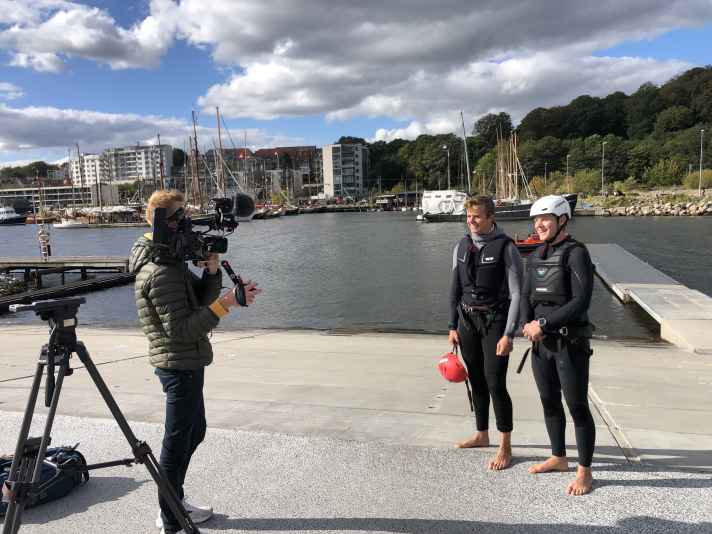
We only learnt many things along the way, such as the ideal setting of the material for long shots.
On the last day in Arhus you were welcomed by many friends and also some media representatives. Did you lean too far out of the window when announcing the arrival day and had to really step on the gas again?
Alfred: We check the forecast before the last day. We had one day with lots of wind ahead of us, followed by two days of calm. So instead of dawdling and then hanging around for two days, we decided to make the most of it again and announced our arrival in Arhus at 17:00. We then set off early and were even able to squeeze in a spontaneous visit to Burger King.
We set off very early and were even able to squeeze in a spontaneous visit to Burger King.
Let me guess - you ordered at Neo so as not to lose any time...
Marinus: (Laughs) The wind was so strong, we had nothing under control. The forecast promised that it would calm down a bit later. As we foiled under the bridge over the Great Belt, we saw the glowing signs of the fast food restaurants on land. I looked over at Alfred and could see that he had exactly the same thought and was already heading straight for the shore. An hour and a few burgers later, the wind actually died down a bit (laughs). The arrival in Arhus was a nice thing, there were a few media representatives and some friends there.
You've known each other for a long time, but do you get to know each other again on a trip like this?
Alfred: I wouldn't say that. We started together in the same surf club when we were ten years old, so we've known each other forever. So you know what you're getting into. The fact that we've been surfing together for so long and have done a trip like Round Denmark is great. We already have a few ideas for further tours but nothing official yet.

